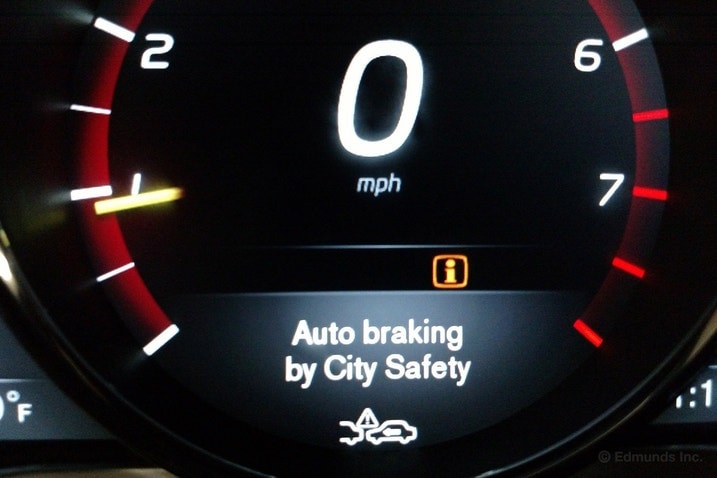Automatic emergency braking (AEB) systems are becoming increasingly common on vehicles of all types and price points, with the tech set to become mandatory on all new vehicles sold in the United States in 2029. The National Highway Traffic Safety Administration (NHTSA) estimates that making AEB a standard feature will save upward of 360 lives per year and prevent about 24,000 injuries. Let us explain how it works.
What is automatic emergency braking?
Automatic emergency braking (sometimes referred to as autonomous emergency braking) is a safety feature that uses vehicle sensors to determine a probable collision, warn the driver, and if necessary stop the vehicle without driver intervention. Some systems will only work when going forward, but many modern systems work for rear collisions as well. Possible collisions are detected via radar, lidar, ultrasonic sensors or vehicle cameras, depending on the automaker’s hardware package for the vehicle.
Automatic emergency braking has become one of the criteria for the Insurance Institute for Highway Safety’s Top Safety Pick testing, underscoring its effectiveness at reducing accidents.
What technologies does AEB with pedestrian detection use?
Many AEB systems will detect not only vehicles or solid objects like walls, bollards or guardrails but also pedestrians. Pedestrian detection systems work similarly to more basic versions in regard to sensors, but they are more sensitive in order to detect a person’s smaller profile or cross-section.
AEB systems are typically integrated with other advanced driver assistance systems (ADAS) in modern vehicles such as adaptive cruise control, lane keeping assistance and blind-spot warning to create a whole suite of safety features that work in conjunction with the driver. These suites often have proprietary names like Nissan’s ProPilot Assist, Toyota’s Safety Sense and Ford’s CoPilot 360.
How does automatic emergency braking work?
To trust that an AEB system will work when you need it to, it helps to understand how the system works. While the finer points will vary from manufacturer to manufacturer, they are all broadly similar.
The first step in an automatic emergency braking intervention is identification. The system will use its sensor package — we’ll use radar as an example here — to detect an object in the vehicle’s path. Once that occurs, the vehicle will determine that you haven’t started to slow for the object, and based on a proprietary algorithm, it will give the driver some type of audible and visual warning.
If the driver hasn’t reacted to the warning and the object is still in the vehicle’s path, the vehicle will intervene and apply the brakes. This is done through the vehicle’s antilock braking system and, depending on the vehicle, the brake application can be quite sudden and forceful in an effort to stop the vehicle as quickly as possible. Other systems won’t fully apply the brakes and require driver intervention to come to a complete stop.
Can I turn off automatic emergency braking?
As with most modern ADAS systems on most vehicles, drivers can typically disable automatic emergency braking entirely or reduce its sensitivity. Often you disable or adjust it through the car’s infotainment system, but we’d recommend leaving the system on unless it’s malfunctioning. Sometimes what seems like a malfunction can just be an overly sensitive calibration.
Automatic emergency braking problems
As we mentioned previously, it’s not unheard of for AEB to go off when it’s not supposed to, for example, in a parking structure with steep ramps. In this instance, the ramps could be seen by the car as obstacles. Simply making the AEB less sensitive would typically solve this issue while leaving it operational to help protect the driver in traffic.
Other problems that can pop up regularly with AEB systems typically involve factors like dirty or damaged radar sensors or cameras. If the car can’t detect an object or pedestrian, it certainly can’t stop for them. The first thing to try if you’re getting such an error is to carefully clean the sensor or camera lens. If that doesn’t help, it may be time to visit a repair shop that can properly diagnose the issue.
There are other issues with AEB that aren’t the result of dirty or faulty hardware. For example, the IIHS has determined in its testing that pedestrian detection systems can struggle at night. One work-around for this issue could be the addition of heat-detecting cameras to current technology, though at the time of publication, no manufacturer has yet released a system with this capability.
When will new cars have to come with AEB?
As we mentioned at the top of this story, the federal government has passed legislation to make automatic emergency braking systems with the ability to detect and respond to cars, objects and pedestrians standard on all new cars sold in the U.S. The law was passed in July 2024 and has a compliance start date of September 1, 2029.
2029 seems like a long way off, and it is, but the good news is that around 90% of the models on sale today in the U.S. come with AEB as standard. Not all of those will detect pedestrians, however, and the new safety standard is arguably out to protect pedestrians.
It’s also likely that we’ll see nearly all vehicles fitted with AEB systems that comply with the new Federal Motor Vehicle Safety Standard (FMVSS) well before that September 1, 2029, deadline.
